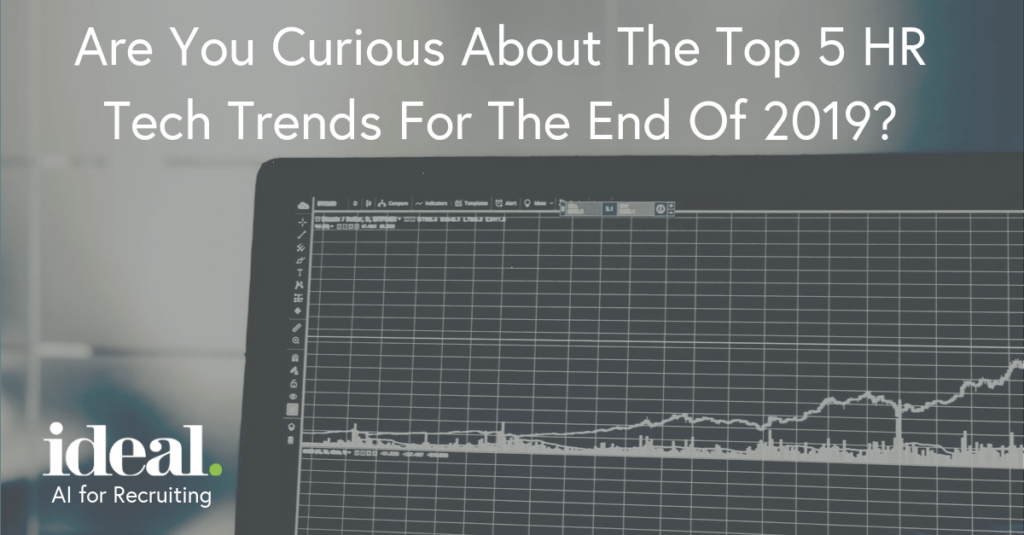Are you wondering what the top 5 hr tech trends this year are going into HR Tech in Las Vegas this week? We’re here to help!

In the last five or so years in HR technology, the big trend has been the rise of artificial intelligence, or AI. The 2018 HR Tech conference in Las Vegas was pretty much all vendors talking about their AI-enabled suites, and that theme is expected to continue at HR Tech 2019 this week. (AI will actually be a major session track at HR Tech ‘19.) This all leads to the idea that HR is now a “product business,” which is increasingly true, and that having AI in your suite of products is now “table stakes.” (Also increasingly true.) AI is still a major tech trend for the HR space, and will increasingly revolutionize what the space can do, especially in recruiting.
What other tech trends within HR should we be thinking about in the final quarter of 2019 and beyond, though?
Robotic Process Automation (RPA)
Michael Moon, the Director of People Insights at ADP, sums this up nicely:
Robotic Process Automation can be used to automate high-volume transactional processes that are repetitive in nature. This can help improve efficiencies resulting in lower labor costs and improve the overall quality of data in HR. When RPA is used HR Shared Services can shift their focus from the transactional elements of their role and instead handle exceptions, while HR Business Partners can get faster access to data and insights while having more confidence in the accuracy of the data due to reduction in processing errors.
The key with most emerging technology is “faster access with less mistakes.” Technology is a force multiplier. The goal is to do things faster and better while minimizing errors or compliance issues. RPA plays right into that.
Increasingly-scalable cloud computing, i.e. SaaS
There are about 128 million full-time workers in the United States, and about 15.17 million full-time employees in Canada. Somewhere around 1.5 billion people work full-time globally. Most of these individuals are working between 30 and 60 hours a week. That is a tremendous amount of data on the workplace, on trends in the workplace, and on each individual workplace and various conceits around its productivity.
It’s actually an overwhelming amount of data to even consider processing, which is why very little has been done with employee data for most of the last 30 years. Yes, there have been surveys and some companies are excellent at understanding turnover costs and the like. Assessment data has been powerful for many organizations.
But as the cloud becomes more scalable, there’s so much potential to collect, sort, analyze and act upon various levels of employee information and company information. We’ll increasingly see “data” become “action,” which right now doesn’t happen most of the time.
The rise of wellness
It’s admittedly become something of a buzzword at one level, but wellness programs are increasingly important to organizations. Lance Haun, a notable “HR influencer,” recently did a whole newsletter on this. Remember: one of the reasons for flat wage growth is corresponding insurance premium growth. It might be possible for employers to pay more in salary/incentives if the insurance side can be managed better, and effective wellness programs can help with that. “Wellness” itself is not technology, but there’s a lot of technology approaches that touch the idea of wellness, notably gamification programs — think about step challenges among employees as one basic iteration of that.
Direct sourcing platforms
One of the great ideas of recruiting in the last 5-10 years has been “Bring great talent directly to you,” i.e. reduce the time on screening and what’s essentially “guesswork” about how good a person might be in your organization. What’s risen up is the direct sourcing platform, where preloaded resumes and employment histories help deliver quality candidates and referrals directly to you. Sourcing and screening are huge uses of recruiter time, as is scheduling interviews and rescheduling those same interviews. If you get a combination of direct sourcing platforms to reduce sourcing and AI to help make scheduling instant, now recruiters — and HR as a whole — have more time to focus on the broader strategy of the department, the approach to people, and more effective onboarding programs.
Consolidation
Have you applied for a job recently? It seems like every organization uses a different ATS. Whereas once there were 3-4 main players, there are now over 100. Same goes with different ways to measure engagement, different assessment tools, different platforms for freelancers, different benefits enrollment tools, etc. It all leads to noted HR technology analyst Josh Bersin saying “the market is a little out of control.” As he logically notes in that article:
Not only is productivity the theme, but simplicity. People are just too distracted and busy with their phones, emails, and messages – so we need HR tools that operate “in the flow of work.” Vendors have to rethink their solutions as “experiences” that integrate into Office 365, Teams, Slack and other tools – and operate flawlessly. We can’t send people to any more “destination apps” unless they are really fun, enjoyable, and valuable to use.
Remember: your HR technology competes directly with Instagram for employee time and headspace. So it needs to be intuitive but also seamlessly integrate with the other work they’re doing, and we will increasingly see vendors provide that in 2019, 2020, and beyond.